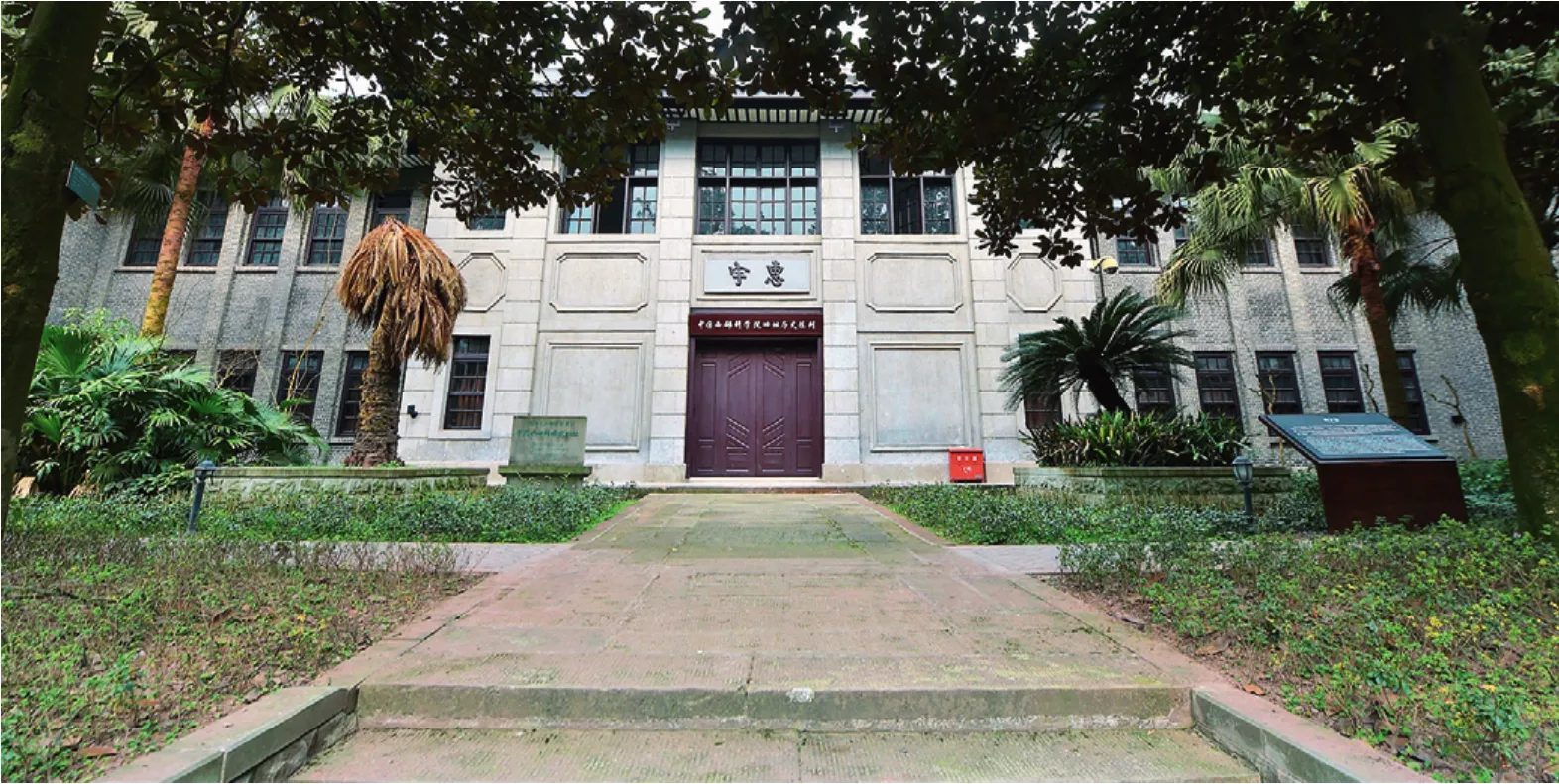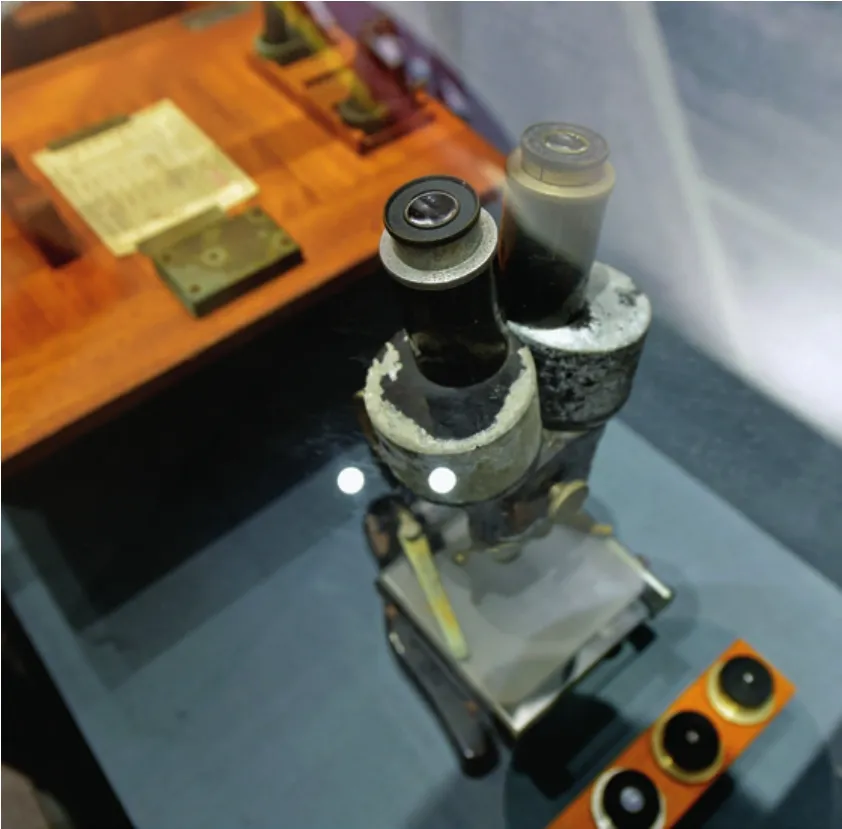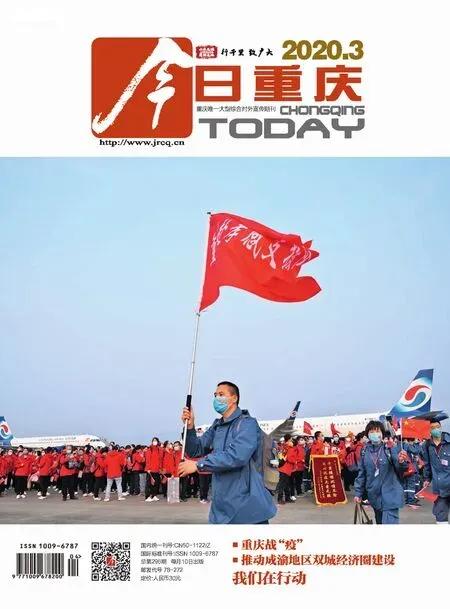西部科学的诺亚方舟
◇ 文 | 本刊记者 胡 婷 图 | 游 宇
在北碚,文星湾42号是个响亮的地名,不少本地人会脱口而出“那不是自然博物馆老馆吗”,然后热心给你指路。
自然博物馆老馆的正门坐落在一条并不宽敞的缓坡半腰上,大门正上方醒目地挂着“重庆自然博物馆”的黄铜牌子,一旁的黑色石牌上还有“中国西部科学院旧址”几个大字。
这处位于嘉陵江西岸小山坡上看似不太起眼的老旧建筑,曾经见证了中国西部科学的大变革,成为中国近现代重要史迹。
When being asked where Wenxing Bay No. 42 is in Beibei, the locals would blurt out “the old site of our natural history museum” and then kindly show you the way.
The original museum is situated halfway up a narrow gentle slope. Right above the door is a bold brass plate written “Chongqing Museum of Natural History”, beside which is a black stone plate saying “Old Site of Science Institute of West China”.
Though seemingly humble and inconspicuous on the hill by the west bank of Jialing River, this building is indeed a meaningful historical site in Chinese modern times that witnessed great scientific changes in west China.
中国第一家民办科学院China’s First Civilian-run Science Institute
在重庆自然博物馆研究员侯江的带领下,我们走进了中国西部科学院旧址。
馆内绿树成荫,青苔铺地,圆形的消防池水已长满水生绿植,阳光透过树叶的缝隙,洒进院内。
穿过法国梧桐的林荫道,拾级而上,首先映入眼帘的的是“惠宇楼”。一楼一底加阁楼,共三层,砖木结构,小青瓦歇山顶,朴素而肃穆。西式的门窗和建筑立面,配上屋顶上飞檐翘角的中式装饰,造型美观,气势恢宏。
这幢历经了80余年风风雨雨的建筑始建于1933年,是西部科学院的标志性大楼。
1930年9月,卢作孚创办的中国西部科学院在重庆北碚诞生,以“从事于科学之探讨,以开发宝藏,富裕民生”为目的,下设理化、地质、生物、农林4个研究所以及博物馆、图书馆和兼善学校。教育救国、实业救国是卢作孚建设北碚最重要的理念之一。当时,建设西部科学院经费压力着实不小。
卢作孚的儿子卢国伦曾说:“我父亲当时是几十个企业的董事、董事长,那么他这部分收入的数额就相当大了,但是他拿回家只有一份,就是民生公司的工资,其余都捐了出来。”
侯江告诉我们,仅1935年,卢作孚就向西部科学院捐助了7600多块大洋。但仅靠个人,西部科学院要运转是不可能的。
为筹措经费,卢作孚曾向社会集资募款。“惠宇楼”就是在1933年由卢作孚向国民政府军政要员杨森劝募3万元修建起来的,当时作为中国西部科学院理化研究所办公楼。
1934年的端午节这一天,时任民生公司总经理的卢作孚,以西部科学院院长的身份,参加了这栋大楼的落成典礼。
We walked into the former site of Science Institute of West China (hereinafter referred to as SIWC) led by Hou Jiang, the researcher in Chongqing Museum of Natural History.
Inside there are shady trees, green moss carpeting the ground, and water plants in the round pool, and sunshine cascades into the yard through layers of leaves.
Through an avenue of plane trees, and up the stairs, there is the three-storey Huiyu Building. It has a wooden frame faced with brick, simple and solemn.Also the doors and windows in western style and the roof in Chinese style add some other beauty and grandeur to the building.
The architecture was built in 1933, witnessing a history of over 80 years. It is a symbolic building in SIWC.
“My father ran dozens of enterprises, which brought in large income. But he only took back home the single salary from Minsheng Shipping Company,and the rest were all donated,” recalled Lu Guolun,son of this great industrialist.
Hou Jiang said that Lu Zuofu offered the science institute as much as 7,600 silver dollars in 1935.However, it was impossible to make it by a single power.
Given the situation, Lu Zuofu launched a public fund-raiser. And Huiyu Building is the one built with the 30,000 Yuan donated by Yang Sen (then a government official)as the office of the physics and chemistry institute.
On the Dragon Boat Festival of 1934, Lu Zuofu,the general manager of Minsheng Shipping Company then, attended the building’s inaugurating ceremony as the dean of SIWC.




源于江畔的学术探险Academic Exploration along Jialing River
推开“惠宇楼”大门,房间里展示着八十年前科学家们探索的经历和成果,从黑白照片和文字中得以窥见中国西部科学院的风雨成长历程。
在卢作孚的北碚规划蓝图中,早就有在嘉陵江边设立一个科学馆的设想。
1927年,卢作孚出任江北、巴县、璧山、合川4县特组峡防团务局局长,利用北碚文昌宫庙宇办公,并以北碚为基点组织嘉陵江三峡乡村建设运动。
1929年,卢作孚派峡防局赴川采集标本。卢作孚胞弟卢子英率领峡防局少年义勇队赴川边采集标本,这次的考察使西部科学院的筹建迈出了第一步。
中国西部科学院成立后,李乐元、常隆庆、施白南等科学家来到中国西部科学院,相继对四川的煤炭资源、北碚观音岩矿石水泥原料、四川嘉陵江下游鱼类等展开研究,《四川煤炭化验第一次报告》《四川植物采集记》等一大批科研论文、科研报告问世。
在生物研究展示厅,从当年的报纸和照片中,我们看到了12个人在草地上行走。这张图,就是研究人员在去四川雷马峨屏调查的现场图片。
1934年春,中国西部科学院组织的雷马峨屏考察团,由生物研究所和地质研究所共同派员,赴雷马峨屏各县及大小凉山实地工作。
在近1年的艰辛考察后,常隆庆、施怀仁、俞德浚写出了《四川雷马峨屏调查记》。这是学术团体第一次对凉山地区的较为彻底的考察。
In the rooms of Huiyu Building display some black-and-white pictures and passages recording the exploration journeys and achievements our scientists made eighty years ago.
In Lu Zuofu’s blueprint for Beibei’s development, there was long ago a conception of setting up a science institute by Jialing River.
In 1927, Lu Zuofu served as the leader of the special gorge-defense bureau of Jiangbei, Baxian County, Bishan County and Hechuan County. He took Wenchang Temple as the office and Beibei as the base to organize the countryside construction by the three gorges of Jialing River.
In 1929, Lu Zuofu assigned his brother Lu Ziying to lead a team of the gorge-defense bureau for collecting samples at the border of Sichuan Province.This investigation represents the first step in the construction of SIWC.
After the establishment of the SIWC, Li Leyuan,Chang Longqing and Shi Bainan as well as other scientists came to the institute and carried out multiple researches in aspects of coal resources in Sichuan,cement raw materials in Beibei, fishes in the lower reaches of Jialing River, etc. And a bunch of research papers and scientific reports including First Report on Analysis of Coal in Sichuan Province and A Record of Collecting Plants in Sichuan were published to this end.
Among the old newspapers and photographs in the exhibition room of biological study, we found one in which 12 men were walking on the grass. It is said to be a scene of researchers conducting investigation in Yi people’s area Leibo, Mabian, Ebian and Pingshan counties in Sichuan.
In the spring of 1934, the investigation group organized by SIWC and made up with members in the biology and geology institutes set out to exercise a field trip at Leibo, Mabian, Ebian and Pingshan counties as well as the Liangshan region.
After an arduous journey for nearly a year, Chang Longqing, Shi Huairen and Yu Dejun completed A Record of Investigation in Lei, Ma, E, Ping of Sichuan Province.This is the first relatively thorough survey about the Liangshan region for an academic community.

战时学术中心An Academic Center in Wartime
抗战时期,重庆作为陪都成为了当时的政治经济文化中心,而中国西部科学院及其所在地北碚也迎来了许多著名学术机构和专家学者,北碚因此成为当时中国科学界的“诺亚方舟”和“战时学术研究中心”。
在地质馆的展览室,我们看到了“许氏禄丰龙”的模型,恐龙模型按照原比例复制。“这是中国人自己发掘、研究、装架的第一条恐龙。”侯江告诉我们。
1938年,地质调查所新生代动物化石研究室技正卞美年和技工王存义、杜林春在云南省禄丰县沙湾东山坡发掘了“许氏禄丰龙”。
中国地质学家杨钟健在对其研究的过程中写下了“立忍半月地上垢,姑敲一日份内钟”的诗句。不难看出,当时的研究条件极端困难。
中国西部科学院完成装架的“许氏禄丰龙”,让中国人第一次看到了生活在中国的恐龙像什么样子。
在农林展馆内,一张泛黄的图片上,依稀可见农民正在收割西瓜。
据1935年《嘉陵江日报》记载:“中国西部科学院西山坪农场,本年试种西瓜成功后,运往渝合两地出售,现因天气已入秋凉,该场西瓜恰已售完,闻该场主任刘式民先生谈,本年西瓜共售洋三千余元,除开该场职员数月来之薪资及其他开支外,均尚赢余千余元。”
科学成果的逐渐显现,同时也带动了地区文化教育的发展。
1943年12月,中国西部科学院联络中央研究院动植物研究所、经济部中央地质调查所、中国科学社生物研究所等十三个学术研究团体,共同发起筹办了中国西部博物馆。
1944年12月,我国第一家多学科的自然科学博物馆——中国西部博物馆开馆。




During the War of Resistance against Japanese Aggression,Chongqing as the provisional capital of China became then the political, economic and cultural center. And SIWC and Beibei in this way attracted a host of noted academic institutes and specialists and scholars, making it the Noah’s Ark in China’s scientific circle and an academic center during the wartime.


In the exhibition room of the geology institute there is a holotype of Lufengosaurus huenei. “This is the first complete dinosaur skeleton excavated,studied and mounted by our Chinese people,”introduced Hou Jiang.
In 1938, the skull of Lufengosaurus huenei was uncovered at Shawan, Lufeng County of Yunnan Province by senior technical specialist Bian Meinian and technicians Wang Cunyi and Du Linchun from the geology institute.
The excavating work was deadly hard given the conditions at that time.
SIWC has then finished composing the Lufengosaurus huenei skeleton, which has for the very first time made Chinese people see what dinosaurs looked like that once lived in China.
In the agricultural pavilion exhibits a yellowish picture, from which we can dimly see that farmers are harvesting watermelons.
As it was recorded in Jialing River Daily published in 1935. Though faded and worn-out, it can still be seen the news over 80 years ago: At the Xishanping farmland of Science Institute of West China, the trial of watermelons succeeded this year and the fruits were delivered to Chongqing and Hechuan for sale.Later, according to Mr. Liu Shimin, director of the farmland, the watermelons were all sold with over 3,000 Yuan, and apart from covering salaries for the employees and other expenses held back, there was still a profit of over 1,000 Yuan.”
The advance in science also drove development of the local cultural education.
In December, 1943, SIWC together with thirteen academic research communities including Institute of Zoology and Botany under Academia Sinica, Central Geological Survey under the Ministry of Economic Affairs and Institute of Biology under Chinese Academy of Sciences joined efforts in constructing the Museum of West China.
In December 1944, the first multi-disciplinary natural history museum in China—Museum of West China officially opened to the world..

